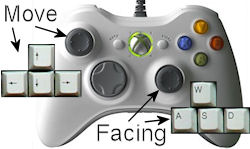3 New Features
I have just improved the system with three new features:
- Support for using walk cycles backwards. So for example a forward walk cycle can be used as a backwards walk cycle too (in lack of something better).
- Auto-synchronization. All walk and run cycles are now synchronized so you don't have to tell your animators "all animations must start on the left foot" or similar.
- Slightly more intelligent foot placement. It attempts to avoid ledges. The system now traces two rays per foot per frame in order to make this possible.
(More details below.) These improvements have been of benefit for the Soldier guy in particular, that only use 3 animations: idle, walk, and run. He now walks much more fluidly in all directions, though still not nearly as well as the Hero guy, with 9 animations. Click the image below to view the demo.
Instructions repeated for your convenience

When manual control is turned on, you can control with either the keyboard (arrow keys for walking direction, and optionally WASD keys for facing direction) or with an analog controller, which I highly recommend. With an analog controller, such as an XBox 360 controller, the direction and speed can be controlled precisely with ease, while independently controlling facing direction with the secondary stick.
The terrain can be dynamically controlled with the sliders at the top. You can create stairs, slopes, and various combinations. The terrain will reflect the changes once the character has walked a little distance to the left or right. The sliders will also be changed at random while not in manual mode.
Support for using walk cycles backwards
Since one of the goals of the system is to make great animation available to even small developers with limited resources, the ability to use the same walk cycle for two things is very handy. Not only can a forward walking animation be used as a backwards walking animation too, but the system can also use a blend of the forward and backward animations for walking sideways. The forward-backward blend results in a sort of neutral stepping on the spot motion, which is better suited for adapting to side-stepping than either the forward or backward animations alone.
Auto-synchronization
This one solves a whole host of problems. If animations are not properly synchronized before they are blended, it results in all kinds of weird motions, quirks, and problems. The traditional approach is to make sure the animators animate the cycles synchronized, so that for example all walk and run cycles starts with the left foot being on the ground, approximately under the character. However, this manual synchronization doesn't always work out very well. Also, when considering the backwards support feature mentioned above, the restrictions are even tighter.
This is why I have implemented auto-synchronization. The system now calculates an offset for each walk and run cycle that makes it match the other cycles as well as possible. At runtime in each frame, these offsets are applied individually to each motion prior to blending them.
The auto-synchronization works by comparing the stance times of each leg in each cycle with the stance times in the other cycles. (The stance time is the time in the cycle when the foot is standing most firmly on the ground.) The offsets are calculated by applying a kind of spring system to the stance times in each cycle, so that each stance time is attracted towards the stance times of the same leg in the other cycles. Over a few iterations (less than 20 in my tests) the stance times get increasingly closer until they are practically overlaid. Each iteration is O(N^2) where N is the number of cycles, because each cycle is compared to each of the other cycles. However, since this calculation can be done once at pre-compile time, it doesn't have any speed penalty at run-time.
More intelligent foot placement
The feet now land on the ground a bit more intelligently. For each foot two rays are cast towards the ground; one from the heel and one from the toe-tip. Depending on whether one of them or both hit a usable spot, the foot is placed either between the two points or on one or the other. This prevents the most glaring intersections with geometry. However, a more sophisticated system might still be implemented at a later time.
Help me test the system
I make the Locomotion System as my Master Thesis in collaboration with Unity Technologies. It will be available for free for users of Unity once it is finished.
As a part of my thesis, I want to test the usability of the system. If you are a Unity user and would like to try out the system and help me by evaluating it, please let me know! The system is not ready for testing yet, but it won't be long now.
Also, comments are much appreciated!